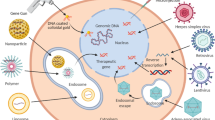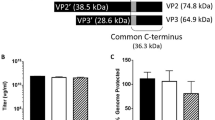Abstract
Application of recombinant adenoviral vectors for cancer gene therapy is currently limited due to lack of specificity for tumor cells. For gastric and esophageal adenocarcinoma, we present here that the relative abundant expression of the primary adenovirus receptor, coxsackie/adenovirus receptor (CAR), on normal epithelium compared to carcinoma favors the transduction of the epithelium. As such, to achieve specific transduction of cancer cells, targeting approaches are required that ablate the binding of the virus to CAR and redirect the virus to tumor-specific receptors. By immunohistochemistry and reverse transcriptase polymerase chain reaction assays, we demonstrate a marked difference in expression of the human epithelial cell adhesion molecule (EpCAM) between normal and (pre)malignant lesions of the stomach and esophagus. Based on this, we explored the feasibility of using EpCAM to achieve gastric and esophageal adenocarcinoma selective gene transfer. Adenoviral vectors redirected to EpCAM using bispecific antibodies against the adenovirus fiber-knob protein and EpCAM specifically infected gastric and esophageal cancer cell lines. Using primary human cells, an improved ratio of tumor transduction over normal epithelium transduction was accomplished by the EpCAM-targeted vectors. This study thus indicates that EpCAM-targeted adenoviral vectors may be useful for gastric and esophageal cancer–specific gene therapy in patients. Cancer Gene Therapy (2001) 8, 342–351
This is a preview of subscription content, access via your institution
Access options
Subscribe to this journal
Receive 12 print issues and online access
$259.00 per year
only $21.58 per issue
Buy this article
- Purchase on Springer Link
- Instant access to full article PDF
Prices may be subject to local taxes which are calculated during checkout
Similar content being viewed by others
References
Meyers MA . Overview In: Meyers MA, ed.Neoplasms of the Digestive Tract: Imaging, Staging, and Management. 1st ed Philadelphia: Lippincott-Raven Publishers 1998 9–19:93–109
Anderson WF . Human gene therapy Nature 1998 392: 25–30
Roth AJ, Cristiano RJ . Gene therapy for cancer: what have we done and where are we going? J Natl Cancer Inst 1997 89: 21–39
Linnenbach AJ, Seng BA, Wu S, et al . Retroposition in a family of carcinoma-associated antigen genes Mol Cell Biol 1993 13: 1507–1515
Perez MS, Walker LE . Isolation and characterization of a cDNA encoding the KS1/4 epithelial carcinoma marker J Immunol 1989 142: 3662–3667
Strnad J, Hamilton AE, Beavers LS, et al . Molecular cloning and characterization of a human adenocarcinoma/epithelial cell surface antigen complementary DNA Cancer Res 1989 49: 314–317
Szala S, Froehlich M, Scollon M, et al . Molecular cloning of cDNA for the carcinoma-associated antigen GA733-2 Proc Natl Acad Sci USA 1990 87: 3542–3546
Simon B, Podolski DK, Moldenhauer G, et al . Epithelial glycoprotein is a member of a family of epithelial cell surface antigens homologous to nidogen, a matrix adhesion protein Proc Natl Acad Sci USA 1990 87: 2755–2759
Edwards DP, Grzyb KT, Dressler LG, et al . Monoclonal antibody identification and characterization of a Mr 43,000 membrane glycoprotein associated with human breast cancer Cancer Res 1986 46: 1306–1317
Litvinov SV, Velders MP, Bakker HAM, et al . EpCAM: a human epithelial antigen is a homophilic cell–cell adhesion molecule J Cell Biol 1994 125: 437–446
Litvinov SV, Balzar M, Winter MJ, et al . Epithelial cell adhesion molecule (EpCAM) modulates cell–cell interactions mediated by classic cadherins J Cell Biol 1997 139: 1337–1348
Basak S, Speicher D, Eck S, et al . Colorectal carcinoma invasion inhibited by CO17-1A/GA733 antigen and its murine homologue J Natl Cancer Inst 1998 90: 691–697
Spurr NK, Durbin H, Sheer D, et al . Characterization and chromosomal assignment of a human cell surface antigen defined by the monoclonal antibody AUA1 Int J Cancer 1986 38: 631–636
Momburg F, Moldenhauer G, Hämmerling GJ, et al . Immunohistochemical study of the expression of a Mr 34,000 human epithelium-specific surface glycoprotein in normal and malignant tissue Cancer Res 1987 47: 2883–2891
Bumol TF, Marder P, de Herdt SJ, et al . Characterization of the human tumor and normal tissue reactivity of the KS1/4 monoclonal antibody Hybridoma 1988 7: 407–415
Zhang SL, Zhang HS, Cordoncardo C, et al . Selection of tumor antigens as targets for immune attack using immunohistochemistry: protein antigens Clin Cancer Res 1998 4: 2669–2676
Haisma HJ, Pinedo HM, van Rijswijk A, et al . Tumor-specific gene transfervia an adenoviral vector targeted to the pan-carcinoma antigen EpCAM Gene Ther 1999 6: 1469–1474
Wilke H, Harstick A, Meyer HJ, et al . Etablierung eines Panels von humanen heterotransplantierten Magenkarzinomen — ein präklinisches Modell In: Schmoll HJ, Pichlmayr R, eds.Aktuelle Therapie Gastrointestinaler Tumoren Heidelberg: Springer 1992 158–163
Graham F, Prevec L . Manipulation of adenovirus vectors In: Morray EJ, Walker JM, eds.Methods in Molecular Biology Vol. 7: Clifton, NJ: Humana Press 1991 109–129
Douglas JT, Rogers BE, Rosenfeld ME, et al . Targeted gene delivery by tropism-modified adenoviral vectors Nat Biotechnol 1996 14: 1574–1578
Bergelson JM, et al . Isolation of a common receptor for Coxsackie B viruses and adenovirus 2 and 5 Science 1997 275: 1320–1323
Lauren P . The two histological main types of gastric carcinoma: diffuse and so-called intestinal type carcinoma Acta Pathol Microbiol Scand 1965 64: 31–49
Watanabe H, Jass JR, Sobin LH, eds WHO International Histological Classification of Tumors. The Histological Typing of Esophageal and Gastric Tumors Berlin: Springer Verlag 1990
Hermanek P, Sobin LH, eds UICC: TNM Classification of Malignant Tumors 4th ed. Second revision Berlin: Springer 1992
Bijl JJ, van Oostveen JW, Kreike M, et al . Expression of HOXC4, HOXC5 and HOXC6 in human lymphoid cell lines, leukemias, and in benign and malignant lymphoid tissue Blood 1996 87: 1737–1745
Songun I, van de Velde CJH, Hermans J, et al . Expression of oncoproteins and the amount of eosinophilic and lymphocytic infiltrates can be used as prognostic factors in gastric cancer Br J Cancer 1996 74: 1783–1788
Martin IG, Simon GC, Birbeck K, et al . Expression of the 17-1A antigen in gastric and gastro-esophageal junction adenocarcinomas: a potential immunotherapeutic target? J Clin Pathol 1999 52: 701–704
Correa P . A human model of gastric carcinogenesis Cancer Res 1988 48: 3554–3560
Miller CR, Buchsbaum DJ, Reynolds PN, et al . Differential susceptibility of primary and established human glioma cells to adenovirus infection: targetingvia the epidermal growth factor receptor achieves fiber receptor-independent gene transfer Cancer Res 1998 58: 5738–5748
Haisma HJ, Grill J, Curiel DT, et al . Targeting of adenoviral vectors through a bispecific single-chain antibody Cancer Gene Ther 2000 7: 901–904
Goldman CK, Rogers BE, Douglas JT, et al . Targeted gene delivery to Karposi's sarcoma cellsvia the fibroblast growth factor receptor Cancer Res 1997 57: 1447–1451
Matsukura N, Hoshino A, Igarashi T, et al . In situ gene transfer and suicide gene therapy of gastric cancer induced byN-ethyl-N′-nitro-N-nitrosoguanidine in dogs Jpn J Cancer Res 1999 90: 1039–1049
Acknowledgements
This study was supported by grants from the Dutch Digestive Diseases Foundation (WS 95-12), the National Institute of Health (R01 CA74242 and R01 HL50255), and the National Cancer Institute (N01 CO-97110). We thank the Department of Surgery of the University Hospital Vrije Universiteit, and the Departments of Surgery and Pathology of the Academic Medical Center, Amsterdam, the Netherlands, for their help to obtain resection specimens from patients with gastric and esophageal adenocarcinomas.
Author information
Authors and Affiliations
Corresponding author
Rights and permissions
About this article
Cite this article
Heideman, D., Snijders, P., Craanen, M. et al. Selective gene delivery toward gastric and esophageal adenocarcinoma cells via EpCAM-targeted adenoviral vectors. Cancer Gene Ther 8, 342–351 (2001). https://doi.org/10.1038/sj.cgt.7700313
Received:
Published:
Issue Date:
DOI: https://doi.org/10.1038/sj.cgt.7700313
Keywords
This article is cited by
-
Sticking to the Problem: Engineering Adhesion in Molecular Endoscopic Imaging
Cellular and Molecular Bioengineering (2020)
-
EpCAM is overexpressed in local and metastatic prostate cancer, suppressed by chemotherapy and modulated by MET-associated miRNA-200c/205
British Journal of Cancer (2014)
-
Effect of increased viral replication and infectivity enhancement on radioiodide uptake and oncolytic activity of adenovirus vectors expressing the sodium iodide symporter
Cancer Gene Therapy (2013)
-
Presence of the Coxsackievirus and Adenovirus Receptor (CAR) in human neoplasms: a multitumour array analysis
British Journal of Cancer (2013)
-
Impact of the coxsackievirus and adenovirus receptor on the adenoma–carcinoma sequence of colon cancer
British Journal of Cancer (2011)



